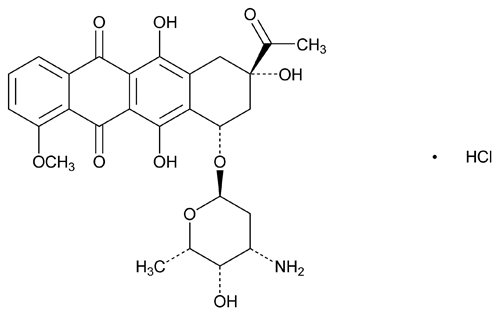Daunorubicin Hydrochloride
(daw'' noe roo' bi sin hye'' droe klor' ide).
5,12-Naphthacenedione, 8-acetyl-10-[(3-amino-2,3,6-trideoxy-
(1S,3S)-3-Acetyl-1,2,3,4,6,11-hexahydro-3,5,12-trihydroxy-10-methoxy-6,11-dioxo-1-naphthacenyl 3-amino-2,3,6-trideoxy-
» Daunorubicin Hydrochloride has a potency equivalent to not less than 842 µg and not more than 1030 µg of C27H29NO10 per mg.
[Caution—Great care should be taken to prevent inhaling particles of Daunorubicin Hydrochloride and exposing the skin to it.
]
Packaging and storage—
Preserve in tight containers, protected from light and excessive heat.
Identification—
A:
The IR absorption spectrum of a potassium bromide dispersion of it exhibits maxima only at the same wavelengths as that of a similar preparation of USP Daunorubicin Hydrochloride RS.
B:
The retention time of the main peak obtained with the Assay preparation corresponds to that obtained with the Standard preparation as directed in the Assay.
Crystallinity  695
695 :
meets the requirements.
:
meets the requirements.
pH  791
791 :
between 4.5 and 6.5, in a solution containing 5 mg per mL.
:
between 4.5 and 6.5, in a solution containing 5 mg per mL.
Water, Method I  921
921 :
not more than 3.0%.
:
not more than 3.0%.
Assay—
Mobile phase—
Mix 62 volumes of water and 38 volumes of acetonitrile, and adjust with phosphoric acid to a pH of 2.2 ± 0.2. The acetonitrile concentration may be varied to meet system suitability requirements and to provide a suitable elution time for daunorubicin. Filter the solution through a membrane filter (1 µm or finer porosity), and degas.
Standard preparation—
Dissolve an accurately weighed quantity of USP Daunorubicin Hydrochloride RS in Mobile phase to obtain a solution having a known concentration of about 250 µg of daunorubicin per mL.
Resolution solution—
Prepare a solution of doxorubicin hydrochloride in the Standard preparation containing about 250 µg per mL.
Assay preparation—
Transfer about 25 mg of Daunorubicin Hydrochloride, accurately weighed, to a 100-mL volumetric flask, dissolve in and dilute with Mobile phase to volume, and mix.
Chromatographic system
(see Chromatography  621
621 )—The chromatograph is equipped with a 254-nm detector and a 4.6-mm × 30-cm column that contains packing L1. The flow rate is about 1.5 mL per minute. Chromatograph the Resolution solution, and record the peak responses as directed for Procedure: the relative retention times are about 0.7 for doxorubicin and 1.0 for daunorubicin; and the resolution, R, between the doxorubicin peak and the daunorubicin peak is not less than 3. Chromatograph replicate injections of the Standard preparation, and record the peak responses as directed for Procedure: the relative standard deviation for replicate injections is not more than 2.0%.
)—The chromatograph is equipped with a 254-nm detector and a 4.6-mm × 30-cm column that contains packing L1. The flow rate is about 1.5 mL per minute. Chromatograph the Resolution solution, and record the peak responses as directed for Procedure: the relative retention times are about 0.7 for doxorubicin and 1.0 for daunorubicin; and the resolution, R, between the doxorubicin peak and the daunorubicin peak is not less than 3. Chromatograph replicate injections of the Standard preparation, and record the peak responses as directed for Procedure: the relative standard deviation for replicate injections is not more than 2.0%.
Procedure—
Separately inject equal volumes (about 5 µL) of the Standard preparation and the Assay preparation into the chromatograph, record the chromatograms, and measure the responses for the major peaks. Calculate the potency, in µg of C27H29NO10 per mg, taken by the formula:
100(C / W)(rU / rS)
in which C is the concentration, in µg per mL, of daunorubicin in the Standard preparation; W is the weight, in mg, of Daunorubicin Hydrochloride taken; and rU and rS are the daunorubicin peak responses obtained from the Assay preparation and the Standard preparation, respectively.
Auxiliary Information—
Please check for your question in the FAQs before contacting USP.
| Topic/Question | Contact | Expert Committee |
|---|---|---|
| Monograph | Ahalya Wise, M.S.
Senior Scientific Liaison 1-301-816-8161 |
(SM12010) Monographs - Small Molecules 1 |
| Reference Standards | RS Technical Services 1-301-816-8129 rstech@usp.org |
USP35–NF30 Page 2811

